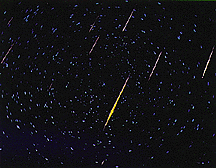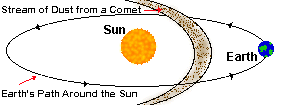![]()
 A "falling star" or a "shooting star" has nothing at all to do with a star! These
amazing streaks of light you can sometimes see in the night sky are caused by
tiny bits of dust and rock called meteoroids
falling into the Earth's atmosphere
and burning up. The short-lived trail of light the burning meteoroid
produces is called a meteor. Meteors are commonly called falling stars or shooting
stars. If any part of the meteoroid survives burning up and actually hits the
Earth, that remaining bit is then called a meteorite.
A "falling star" or a "shooting star" has nothing at all to do with a star! These
amazing streaks of light you can sometimes see in the night sky are caused by
tiny bits of dust and rock called meteoroids
falling into the Earth's atmosphere
and burning up. The short-lived trail of light the burning meteoroid
produces is called a meteor. Meteors are commonly called falling stars or shooting
stars. If any part of the meteoroid survives burning up and actually hits the
Earth, that remaining bit is then called a meteorite.
At certain times of year, you are likely to see a great number of meteors in the night sky. These events are called meteor showers and they occur when the Earth passes through the trail of debris left by a comet as it orbits the Sun. These showers are given names based on the constellation present in the sky from which they appear to originate. For example, the Leonid Meteor Shower, or Leonids, appear to originate in the constellation Leo. It is important to understand that the meteoroids (and therefore the meteors) do not really originate from the constellations or any of the stars in the constellations, however. They just seem to come from that part of the sky because of the way the Earth encounters the particles moving in the path of the comet's orbit. Associating the shower name with the region of the sky they seem to come from just helps astronomers know where to look!
 |
| The dust and rocks that cause meteor showers come primarily from the Earth passing through the debris stream left behind by a comet as it orbits the Sun. Usually, the Earth's orbit and the comet's orbit are slightly tilted relative to one another. So the paths only intersect on one side! |
| Annual Meteor Showers | |
|---|---|
| Name | When They Occur |
| Quadrantids | January 1-6 |
| April Lyrids | April 19-24 |
| Eta Aquarids | May 1-8 |
| Delta Aquarids | July 15- August 15 |
| Perseids | July 25 - August 18 |
| Orionids | October 16-27 |
| Taurids | October 20-November 30 |
| Leonids | November 15-20 |
| Geminids | December 7-15 |
Note that one of the best meteor showers, the Perseids, happens in August. "Peak time" is when you are likely to see the largest number of meteors per hour. It occurs in the middle of August can be quite spectacular to see!
![]()
The StarChild site is a service of the High Energy Astrophysics Science Archive Research Center (HEASARC), within the Astrophysics Science Division (ASD) at NASA/ GSFC.
StarChild Authors: The StarChild Team
StarChild Graphics & Music: Acknowledgments
StarChild Project Leader: Dr. Laura A.
Whitlock
Curator:
Responsible NASA Official: